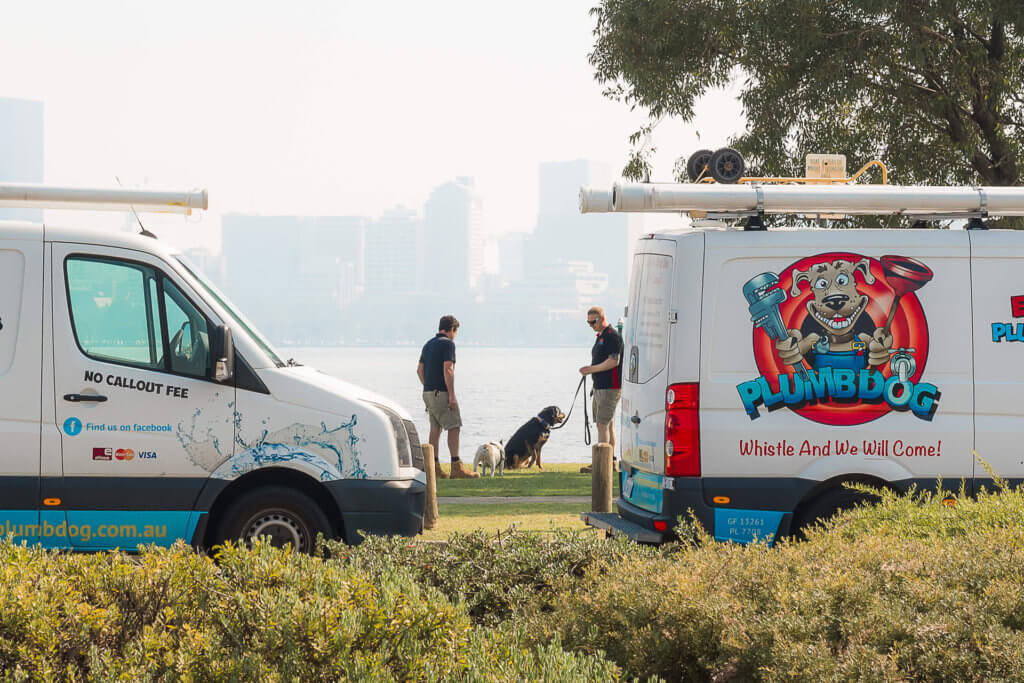Hello everyone it’s Richard at Plumbdog here.
I’m out of the property in Baldivis, Western Australia and I’m in a customer’s bathroom. He has lived here about a year and since he’s moved in he’s noticed all sorts of issues with the moisture around the shower.
You can see behind me there’s moisture coming through somewhere behind the shower screen here sort of adjacent to the shower taps.
The shower outlet is up there. So, about a year ago he had the shower regrouted because it was noticeably poor with the grout, so the grout guys came and sort of ripped that out and revamped it but he’s still got moisture problems. The client said he had a plumber out last week who looked at the taps and resurfaced them and just sort of put them back and couldn’t really explain too much so he’s got us out for leak detection.
The first thing I want to do is test the water meter at the water main coming in and I just want to look at the small needle on here and see if there’s any movement so I’m doing a five minute test and see if that needle moves at all.
During a test on the water meter here, I noticed that the needle is moving but it’s moving really really slowly and it’s losing about one litre every four to five minutes, so there is a leak on the main but because that’s inside and it’s just showing signs of sort of damp and moisture inside, I’m pretty sure there’s not a litre of water lost every four to five minutes inside the house because as you can expect it’d be a swimming pool in there so there is a leak on here somewhere but I don’t think that’s it, so what I’m going to do is, I can see that the reticulation connection is just there, the master valve and the master solenoid. I’m just going to isolate them and then just re-test just to see if that makes any difference.
I’m retesting now and now I’ve isolated the retic and there’s no movement, no movement whatsoever over five minutes so we’re not losing any water which is a good sign but I was hoping to find a little bit of loss somewhere because we know that there’s signs of moisture inside so if it’s not on the water main then it’s not anywhere in the pipe work to the taps.
The next thing to do is to test from the taps to the shower rose because that’s the next place where there could be leaks so we’re going to do a pressure test but the water meters are no longer moving when nothing’s been used in the house. Behind the shower here in the bedroom cupboard you can see the plaster is really flaky directly behind the shower taps. I’m removing the shower rose so that we can get the threaded outlet there in order to test using the pressure gauge.
I’m tightening on the flexi hose to the pressure gauge there, just making it watertight in order for us to test. I opened up the taps in no particular order, a hot one first in this case. Once they’re opened and pressurised close them back up so now we’ll perform a test between the shower taps and the outlet. I’m carrying out this test over five minutes to make sure there’s no drop and in this case there is no drop so there is no leak between the taps and the shower outlet.
I’m just turning off the water main opening the taps back up and leaving them open, observing the pressure and now over five minutes we are testing all the way back from the shower rose, all the way back to the main stop tap. Again, there is no pressure loss detected so there is no leak on the main supply pipe all the way back to the meter. We’ll just open up the main again so the water’s back on. The test is completed so I remove the pressure gauge and release the pressure there, using thread tape on the thread there and then reattaching the shower rose.
It’s important here, once it’s back on to test for leaks because if there’s any leaks guess where it’s going to go? It’s going to go behind the tiles and make the situation worse. Okay, so the silicon around the spindles there, this should have been done by the previous plumber because when the shower is in use the water can get behind those flanges and behind the tiles. I’m also spraying with soapy water to get rid of that excess silicon and wipe away and as you can see my spray bottle has seen better days – time for a new one.
So that’s my test complete. I’ve done the main test on the meter, got a pressure test on the shower breach, and I’ve checked the taps. They were previously serviced last week. I think that plumber has actually solved the issue. I think the taps were leaking and they are quite old and I would’ve recommended replacing them so he has serviced them and put them all back together.
I do think that solved the problem but as you saw he hadn’t actually siliconed around the spindles there so with the shower in use, water would have got behind there and made the problem just as bad again. so that’s been done. Some recommendations to the client, or what I think he should do, I think they need to peel off some of that plaster get back to the brick and let it dry and it should dry before they sort of spend any more money on regrouting and what have you and then they can give us a shout if they’ve got continual problems but there’s no leaks on the water main with the retic isolated, there’s no leaks on the pipe work between the taps and the shower rose, so that’s all good.
The grouting and ceiling looks good so I think he’s good to go. I think the problem has been solved. Thank you for watching – I hope you learned something and we look forward to seeing you on the next video.
Take care guys, see you later!


